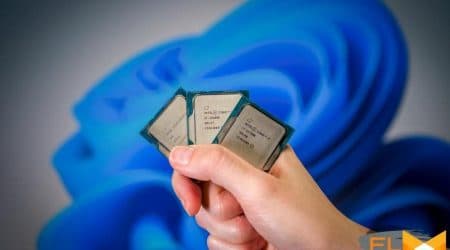


Honor continues to upgrade its mainstream MagicBook series laptops – you can even say that it bakes them like hot cakes with enviable frequency and speed. This time, models with 14- and 15-inch screens have undergone modernization, the latter of which received the BMH-WFQ9HN index. Now the laptop is based on the new AMD Ryzen 5 5500U processor, got a brighter screen, twice the amount of RAM and a fast network controller, but for some reason a relatively slow SSD. Added novelty and cost. In some ways, the laptop has become better, much has not changed in it, and we will talk about all this in today’s material.
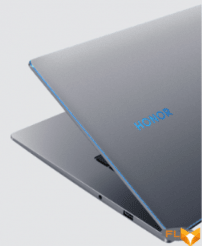
Packaging
In the box of the new Honor MagicBook 15, there have definitely not been any changes – it’s still the same flat case with a plastic handle and a sticker on the end.
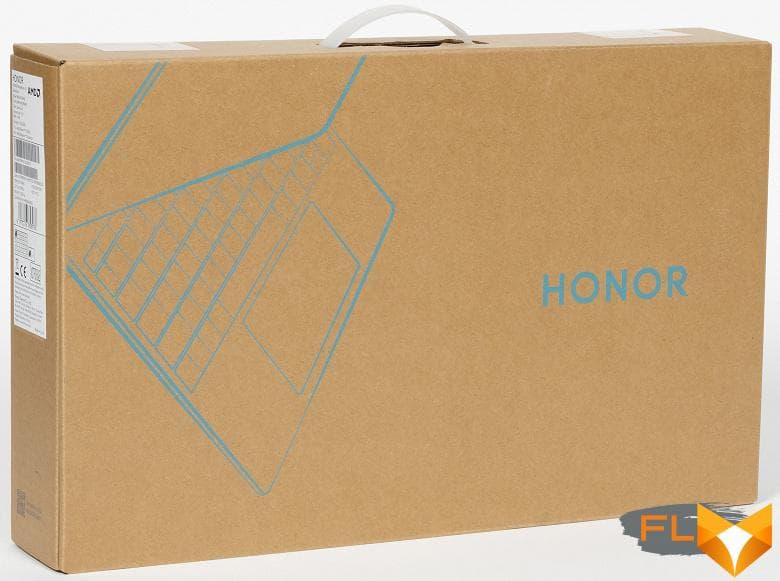
Inside the box, the laptop is secured with a pair of soft polyethylene foam shells and additionally sealed in a matte bag. A cardboard case with two compartments is inserted on the side of the laptop: under the power adapter and under its USB Type-C cable.

In addition to them, inside the box you can find a warranty card and a memo.
Notebook Configuration
Like all previous Honor models, the new MagicBook 15 BMH-WFQ9HN is made in China and comes with a one-year warranty. The official cost of this model is 1200 dollars, that is, the novelty is 150 dollars more expensive than the previous model with the index BOHL-WDQ9HN.
| Honor MagicBook 15 BMH-WFQ9HN | ||
|---|---|---|
| Processor | AMD Ryzen 5 5500U (7nm, 6 cores/12 threads, 2.1-4.0GHz, 8MB L3 cache, TDP 10-25W) | |
| Chipset | AMD Ryzen SoC | |
| RAM | 16 (2×8) GB DDR4-3200 (soldered), dual-channel, 22-22-22-52 CR1 timings | |
| Video subsystem | Integrated AMD Radeon Graphics | |
| Screen | 15.6″ IPS (BOE0936), Full HD 1920×1080 pixels, 60Hz, 300 nits brightness, 1000:1 contrast ratio, 100% sRGB coverage, TÜV Rheinland certified for blue light reduction and flicker reduction | |
| Sound subsystem | Conexant CX8070 codec, 2 stereo speakers | |
| Accumulator | 1xSSD 512GB (SSSTC CL1-8D512, M.2 2280, NVMe 1.3, PCIe 3.0 x4) | |
| Card Reader | none | |
| Network interfaces | Wired network | none |
| Wi-Fi network | Intel Wi-Fi 6 AX200NGW (802.11ax, MIMO 2×2, 2.4 and 5 GHz, channel width up to 160 MHz, 2.4 Gbps) | |
| Bluetooth | Bluetooth 5.2 | |
| Interfaces and Ports | USB | 1×USB 3.2 Gen1 (Type-A) 1×USB 2.0 (Type-A) 1×USB 2.0 (Type-C), 20V/3.25A (65W) charging support |
| RJ-45 | none | |
| Video outputs | HDMI 2.0 | |
| Audio connectors | combined (microphone input, also known as headphone output) | |
| Input Devices | Keyboard | membrane without digital block and without backlight |
| Touchpad | two buttons, 120×72 mm | |
| VoIP | Webcam | 720p@30 FPS hidden in a keyboard key |
| Microphone | 2 microphones | |
| Battery | Lithium Polymer 56 Wh (7330 mAh) | |
| Power adapter | HN-200325EP0, 65W (20.0V, 3.25A), 157g, 1.75m cable | |
| Dimensions | 358×230×21mm (front thickness 16.5mm) | |
| Weight without power adapter: declared/measured | 1540 / 1584 g | |
| Available laptop case colors | “Space Gray” | |
| Other features | aluminum housing support for the “Multi-screen” function retractable camera power button with built-in fingerprint reader Honor PC Manager battery charging from 1% to 65% in 60 minutes |
|
| Operating system | Windows 10 Home | |
| Official Price | $1200 | |
Hull appearance and ergonomics
Compared to last year’s Honor MagicBook 15 (BOHL-WDQ9HN) on the AMD Ryzen 5 4500U processor, with which we will constantly compare the new product today, the design of the laptop has not changed. Outwardly, these models are indistinguishable at all. The color is still called “Space Grey”, the materials are aluminum and plastic.
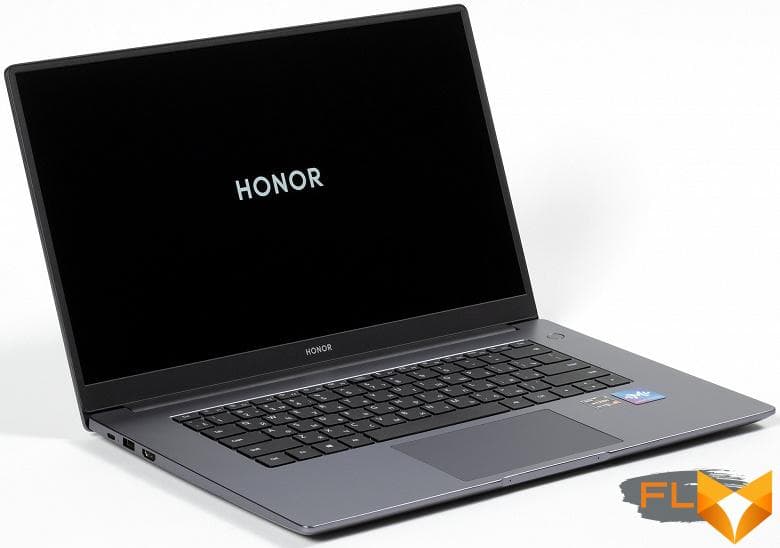
The design is calm, working. Among the decorative elements of the case, one can single out a turquoise chamfer on the laptop lid, obtained by processing on a diamond machine. It changes color from different angles.
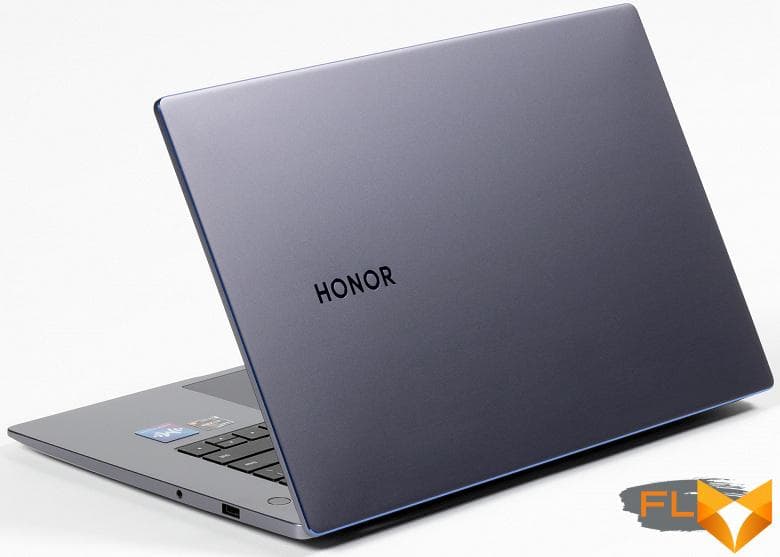
The dimensions of the laptop are 358×230×21 mm (front thickness – 16.5 mm), and its weight is 1584 g.
The plastic base contains a ventilation grille, two small speaker grilles and legs.
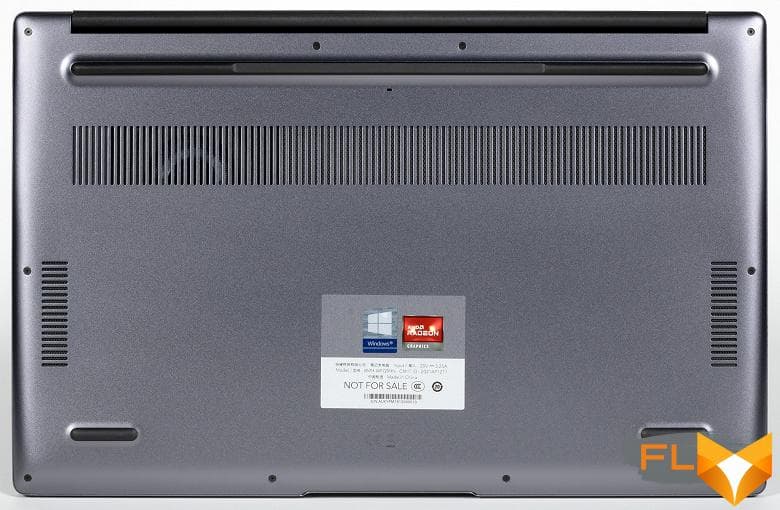
Tapering towards the front end of the case makes the laptop visually thinner. Strictly in the center there is a notch for more convenient hooking of the lid when opening and two small dots – built-in microphones.


By the way, the laptop screen cannot be opened with one hand, the base has to be held.
Interface ports are brought to the side ends of the case. Unfortunately, the set of ports remains as poor as before. On the left is a USB Type-C (and version 2.0) used for charging, a USB 2.0 Type-A port and an HDMI video output, and on the right is a combo headphone and microphone jack, as well as a single fast USB 3.0 Type-A port (now in the specifications Honor proudly calls it USB 3.2 Gen1).


The laptop lid leans back 170 degrees, while its lower end rests against the table surface, and there are no stops on it. It can be assumed that over time the presentation will be lost.

The build quality of the case and the materials used do not cause any complaints. At least while the laptop is new, no squeaks, clicks and other overtones have been identified.
Input Devices
The keyboard in the Honor MagicBook 15 BMH-WFQ9HN is the same as a year ago: without a numeric keypad and without a column of keys with PgUp and PgDn, although there is plenty of space on the working panel.
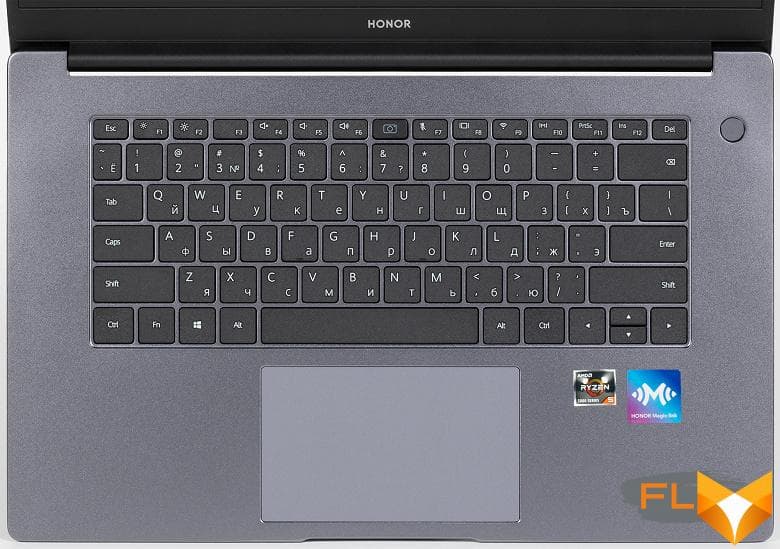
All the same reduced up and down arrows, which are inconvenient to use. The key travel is 1.4 mm, pressing soft and quiet, almost no feedback is felt.
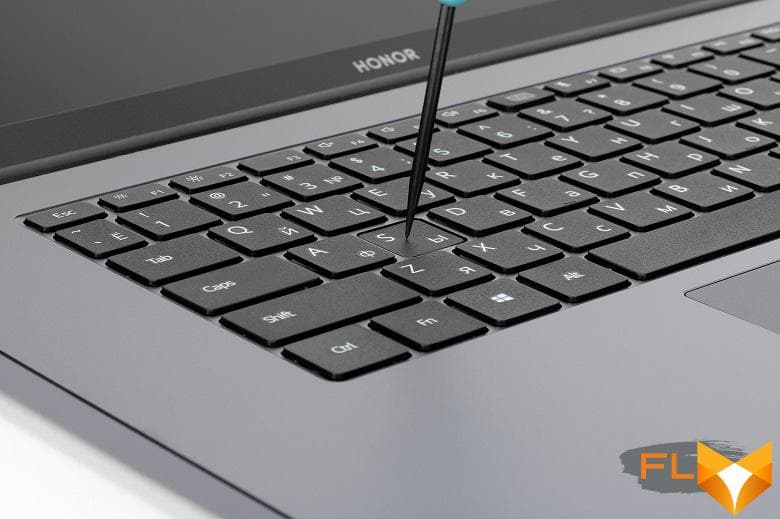
Recall that the dimensions of the main keys are 16 × 16 mm, and the functional keys are 15.5 × 8.5 mm. The keyboard has no backlight.
The two-button touchpad measuring 120 × 72 mm has not changed either.
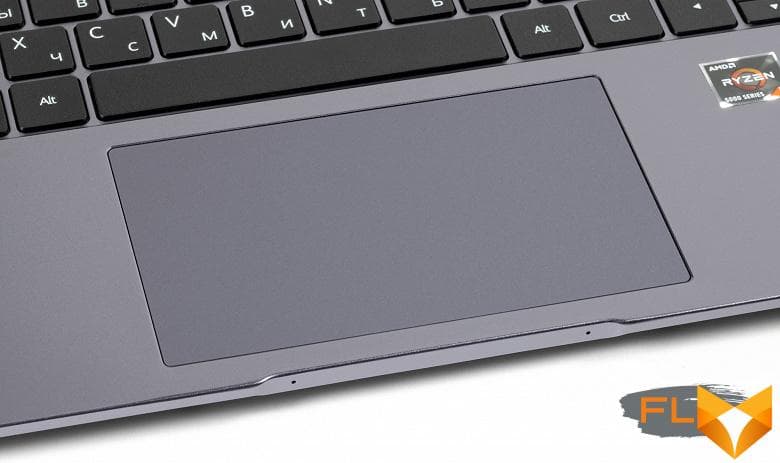
It is convenient that he is not small, it is comfortable to work with him. Pressing the buttons is clearly felt, there were no accidental operations during the entire testing period.
The laptop’s webcam is located in the central function button and opens up after a light press on it. Camera resolution – 720p (HD).
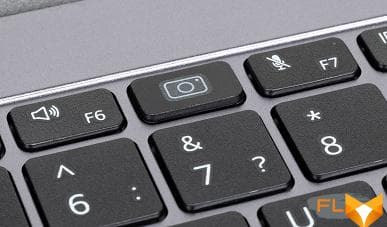
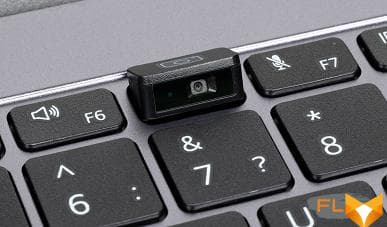
Adjusting the opening angle is not provided, getting into the frame will have to be adjusted by placing something under the laptop case in front or behind (free life hack, use it).
In the far right corner of the working panel there is a laptop power button with a built-in fingerprint scanner.
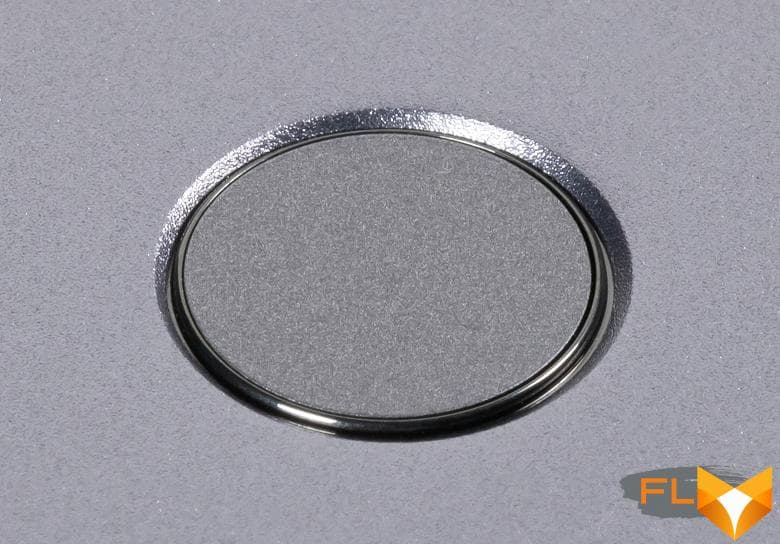
Screen
The new Honor MagicBook 15 (BMH-WFQ9HN) laptop uses a 15.6-inch IPS-matrix with a resolution of 1920 × 1080 pixels. The sides and top of the screen bezel are 6.0mm wide (claimed 5.3mm, but there may be differences in understanding the reference points), while the bottom is 18.0mm. The usable screen area declared in the specifications is 87%.
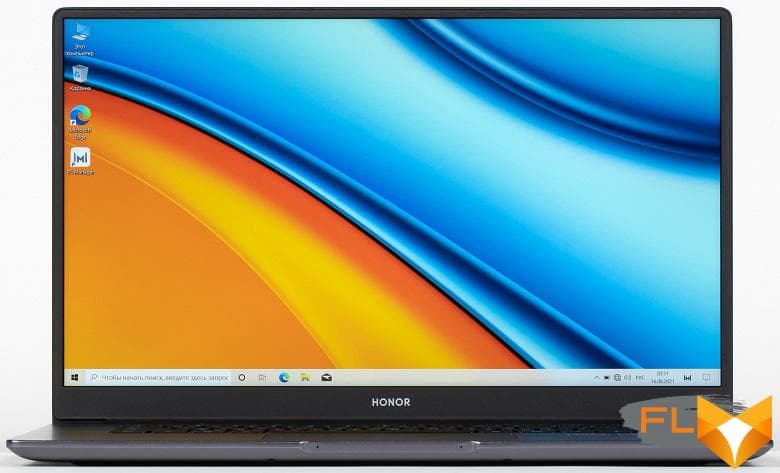
The outer surface of the matrix is black, hard and semi-matt (the mirror reflection is well expressed). There is no special anti-reflective coating or filter, and there is no air gap. When powered by mains or battery and with manual brightness control (no automatic adjustment by light sensor), its maximum value was 358 cd/m² (in the center of the screen on a white background). If you avoid direct sunlight, then this value allows you to somehow use the laptop on the street, even on a sunny summer day. Note that the brightness of last year’s model of the same notebook was only 265 cd/m², meaning the new model has a noticeably brighter screen.
To evaluate the readability of the screen outdoors, we use the following criteria obtained from testing screens in real conditions:
| Maximum brightness, cd/m² | Conditions | Readability Score |
|---|---|---|
| Matte, semi-matte and glossy screens without anti-glare | ||
| 150 | Direct sunlight (over 20,000 lux) | illegible |
| Light shadow (about 10000 lux) | barely readable | |
| Slight shade and light clouds (no more than 7500 lux) | uncomfortable to work | |
| 300 | Direct sunlight (over 20,000 lux) | barely readable |
| Light shadow (about 10000 lux) | uncomfortable to work | |
| Slight shade and light clouds (no more than 7500 lux) | work comfortably | |
| 450 | Direct sunlight (over 20,000 lux) | uncomfortable to work |
| Light shadow (about 10000 lux) | work comfortably | |
| Slight shade and light clouds (no more than 7500 lux) | work comfortably | |
These criteria are very conditional and may be revised as data accumulate. Note that there may be some improvement in readability if the matrix has some kind of transreflective properties (part of the light is reflected from the substrate, and the image can be seen in the light even with the backlight turned off). Also, glossy matrices, even in direct sunlight, can sometimes be rotated so that they reflect something quite dark and uniform (on a clear day, for example, the sky), which will improve readability, while matte matrices need to be blocked from Sveta. In rooms with bright artificial light (about 500 lux), you can work more or less comfortably even with a maximum screen brightness of 50 cd / m² and below, that is, in these conditions, maximum brightness is not an important value.
Let’s return to the screen of the tested laptop. If the brightness setting is 0%, then the brightness is reduced to 7 cd/m². In complete darkness, the brightness of its screen can be lowered to a comfortable level.
At any brightness level, there is no significant backlight modulation, so there is no screen flicker. As proof, here are graphs of the dependence of brightness (vertical axis) on time (horizontal axis) at various values of the brightness setting:
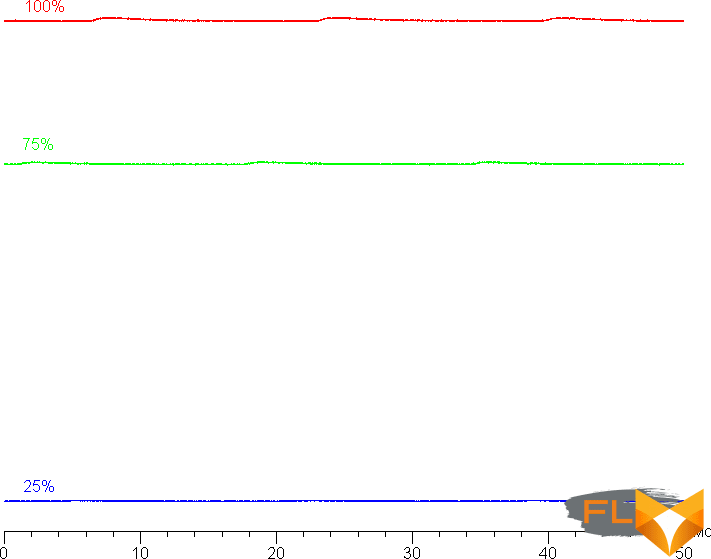
This laptop uses an IPS type matrix. Micrographs show a typical IPS subpixel structure (black dots are dust on the camera’s matrix):
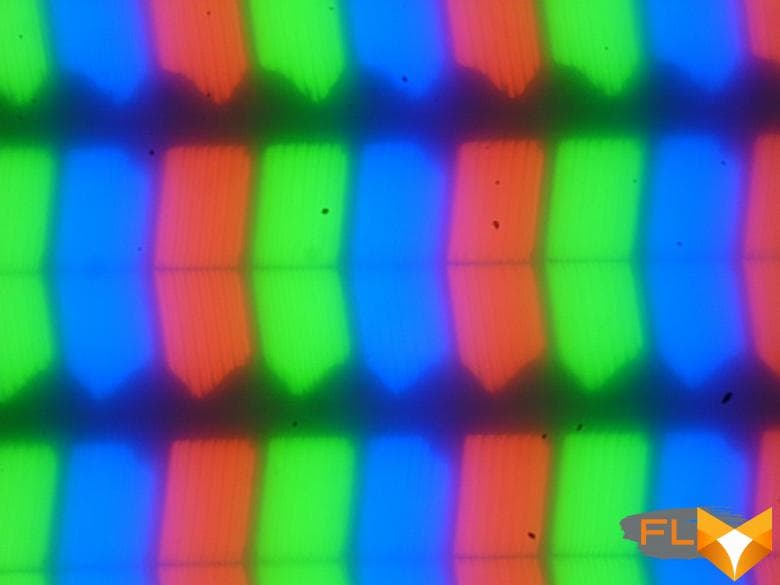
Focusing on the screen surface revealed randomly located surface microdefects, which are responsible for the matte properties:
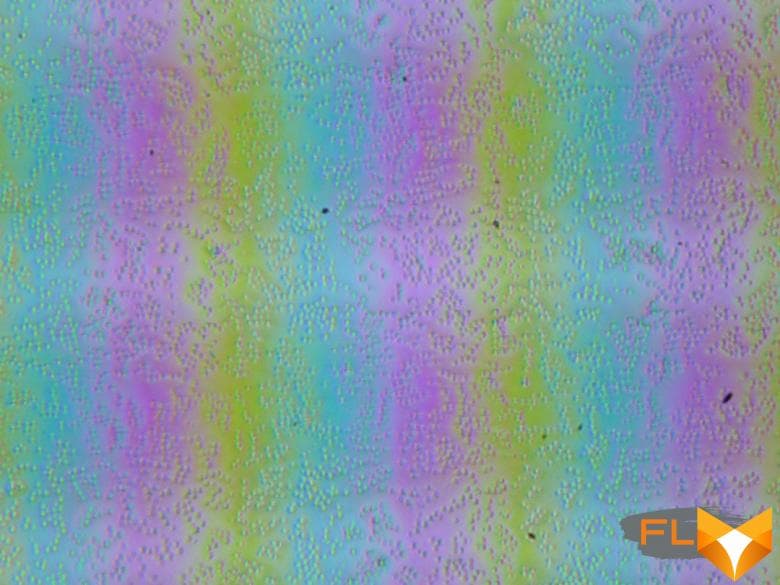
The grain of these defects is several times smaller than the size of the subpixels (the scale of these two photographs is approximately the same), so the focusing on microdefects and the “jumping” of the focus on the subpixels with a change in the angle of view are weakly expressed, because of this there is no “crystal” effect.
We measured brightness at 25 screen points spaced in 1/6th increments of the screen width and height (screen borders not included). The contrast was calculated as the ratio of the brightness of the fields at the measured points:
| Parameter | Average | Mean Deviation | |
|---|---|---|---|
| min., % | max % | ||
| Black box brightness | 0.36 cd/m² | −9,4 | 14 |
| White box brightness | 355 cd/m² | −5,9 | 3,9 |
| Contrast | 1000:1 | −18 | 8,0 |
If you step back from the edges, then the uniformity of the white field is very good, and the black field and, as a result, the contrast is worse. Contrast by modern standards for this type of matrices is typical. The photo below gives an idea of the distribution of the brightness of the black field over the screen area:

It can be seen that the black field is mostly highlighted closer to the edge. However, the uneven illumination of black is visible only on very dark scenes and in almost complete darkness, it should not be considered a significant drawback. Note that the rigidity of the lid, although it is made of aluminum, is low, the lid is slightly deformed at the slightest applied force, and the nature of the black field illumination changes greatly due to deformation.
The screen has good viewing angles without significant color shift even at large deviations of the gaze from the perpendicular to the screen and without inverting shades. However, the black field, when deviated diagonally, is strongly highlighted and acquires a reddish tint.
Black-White-Black transition response time 20ms (11ms on + 9ms off), grayscale transition total (from hue to hue and back) takes 29ms on average. The matrix is not fast, there is no overclocking.
We determined the total output delay from switching pages of the video buffer to the start of displaying the image on the screen (recall that it depends on the features of the Windows OS and the video card, and not just on the display). At 60Hz refresh rate, the latency is 11ms. This is a small delay, it is absolutely not felt when working on a PC, and even in very dynamic games it will not lead to a decrease in performance.
Two refresh rates are available in the screen settings – 60 and 48 Hz. The second can be useful when watching movies.

At least at native screen resolution, the output is at a color depth of 8 bits per color.
Next, we measured the brightness of 256 shades of gray (from 0, 0, 0 to 255, 255, 255). The graph below shows the increase (not an absolute value!) in brightness between adjacent halftones:
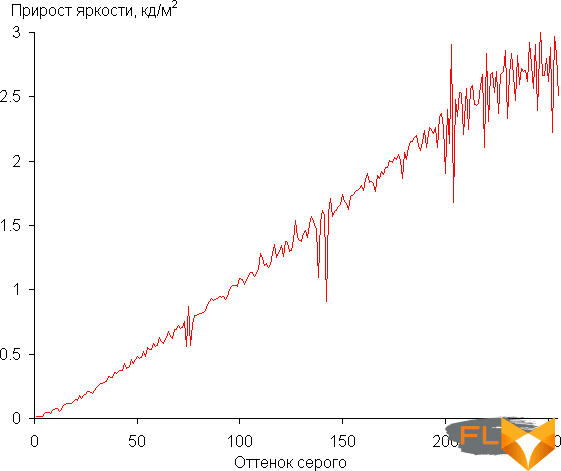
The increase in brightness is quite uniform, and each next shade is brighter than the previous one. In the darkest area, all shades are well distinguished:
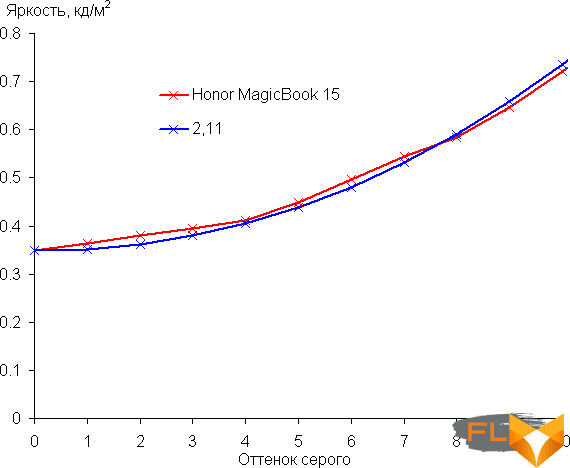
Approximation of the resulting gamma curve gave an indicator of 2.11, which is lower than the standard value of 2.2, that is, the picture is slightly brightened. In this case, the real gamma curve deviates little from the approximating power function:
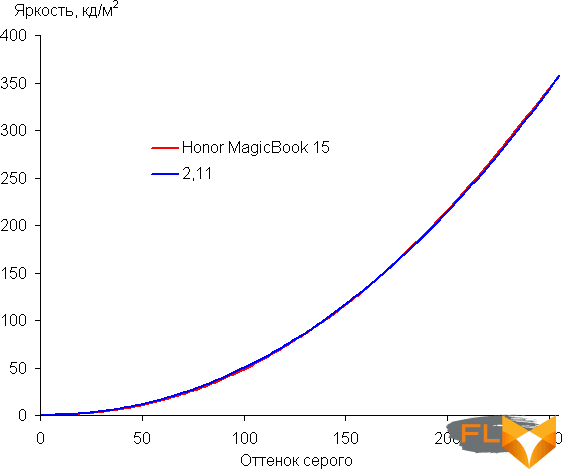
The manufacturer talks about a color gamut of 100% sRGB, and it is really very close to that:

Therefore, the colors of normal images optimized for display on devices with sRGB coverage are naturally saturated. Below is the spectrum for a white field (white line) superimposed on the spectra of red, green and blue fields (lines of the corresponding colors):
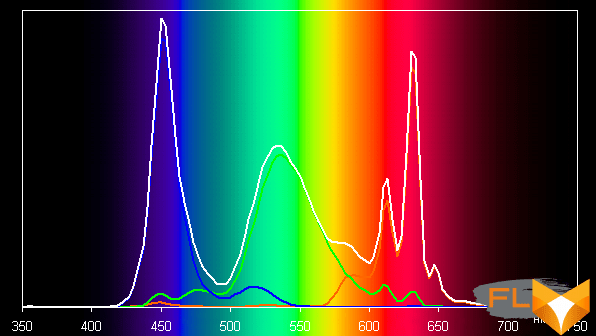
Apparently, this screen uses LEDs with a blue emitter and a green and red phosphor (usually a blue emitter and a yellow phosphor), which in principle allows you to get a good separation of the components. Yes, and in the red phosphor, apparently, the so-called quantum dots are used. However, specially selected filters perform cross-mixing of components, which narrows the coverage to sRGB.
The balance of shades on the gray scale is good (plots Uncorrected in the figures below), since the color temperature is quite close to the standard 6500 K, and the deviation from the black body spectrum (ΔE) is below 10, which is for consumer device is considered acceptable. At the same time, the color temperature and ΔE change little from shade to shade – this has a positive effect on the visual assessment of color balance. (The darkest areas of the gray scale can be ignored, since the color balance does not matter much there, and the measurement error of color characteristics at low brightness is large.)


Additionally, by moving the dot on the color wheel in the screen settings, we tried to correct the color balance. The result is presented in the charts above with the caption corr.
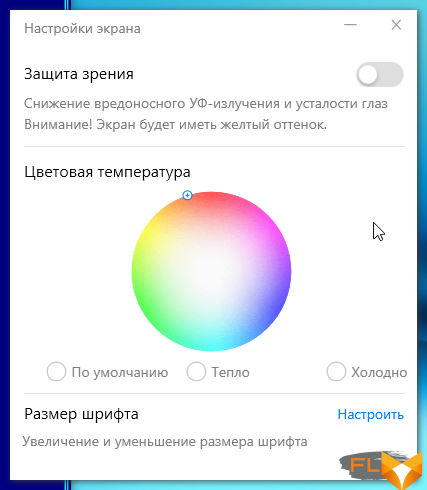
The correction made it possible to significantly improve the color balance, but there is no particular need for such a correction.
Enabling the Eye protection option reduces the intensity of the blue component, by how much – you can correct it with the slider (in Windows 10, the corresponding setting is already there). In any case, when working at a laptop at night, it is better to reduce the screen brightness to a low, but still comfortable level. There’s no point in coloring the picture.
Let’s summarize. The screen of this laptop has a high enough maximum brightness (358 cd/m²) to allow the device to be used outdoors on a bright day, shielded from direct sunlight. In complete darkness, the brightness can be reduced to a comfortable level (up to 7 cd / m²). The advantages of the screen include a low output latency (11 ms), good color balance and sRGB color gamut. The disadvantages are the low stability of black to the deviation of the gaze from the perpendicular to the plane of the screen. In general, the screen quality is high.
Internal arrangement and accessories
The internal layout of the laptop has changed only in part of the disappeared space for a 2.5-inch drive, which was useless, since there was no connector for connecting such a drive. Due to this, a battery of increased size and capacity was installed.
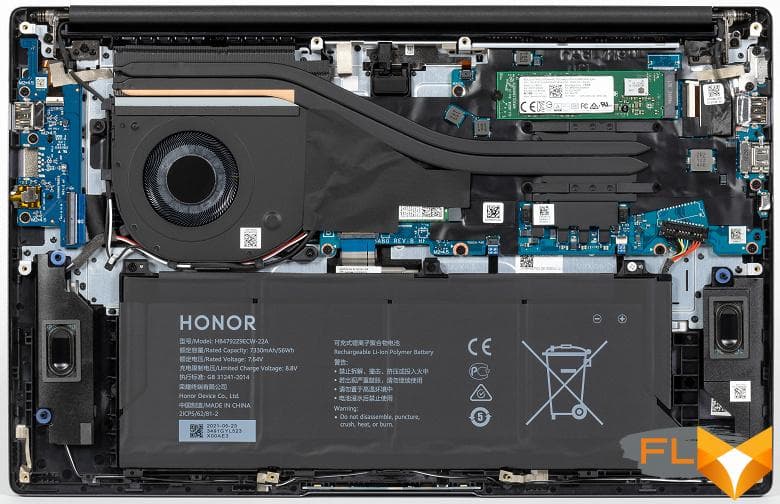
We will return to the battery, but for now let’s go through the main components of the Honor MagicBook 15 BMH-WFQ9HN.
The motherboard is based on the AMD Promontory chipset and has BIOS version 1.01 dated July 22, 2021 (quite recent for a laptop).

The main change of the new Honor MagicBook 15 is in the processor. Now, instead of the six-core and six-thread AMD Ryzen 5 4500U, the laptop has an AMD Ryzen 5 5500U, the main difference of which is twelve threads instead of six and an increased L3 cache to 8 MB.
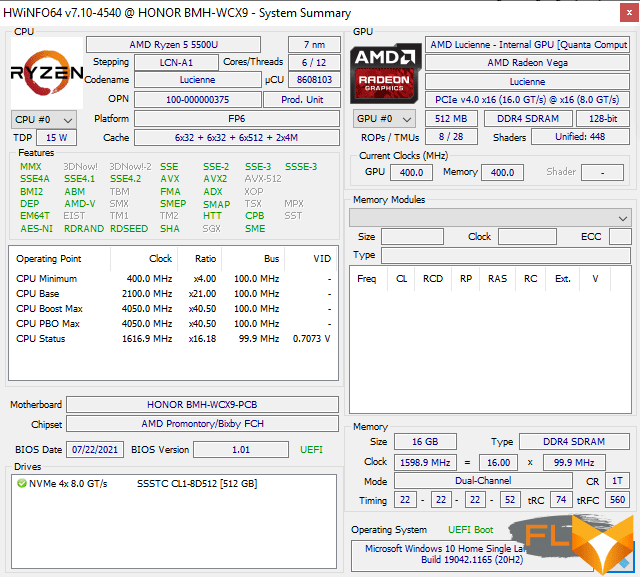
The turbo frequency of the processor can reach 4.05 GHz, and the maximum TDP is 25 watts.
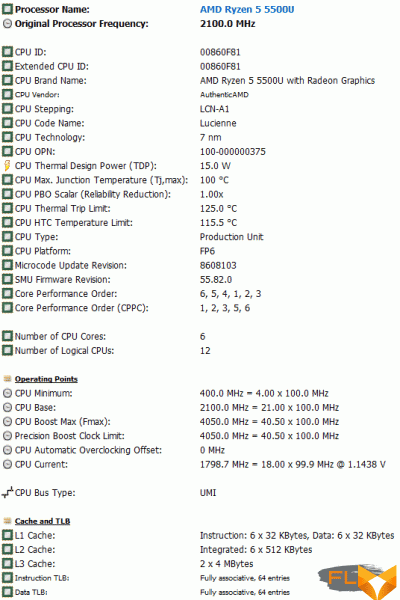
In other words, with the same thermal package and frequency, the processor is capable of processing twice as many threads, which, in general, was lacking in the AMD Ryzen 5 4500U.
The second important difference was the amount of RAM and its frequency. While last year’s Honor MagicBook 15 only had 8GB of non-expandable DDR4 memory running at 2.67GHz, the new model with the BMH-WFQ9HN index has 16GB of memory at an effective 3.2GHz frequency.
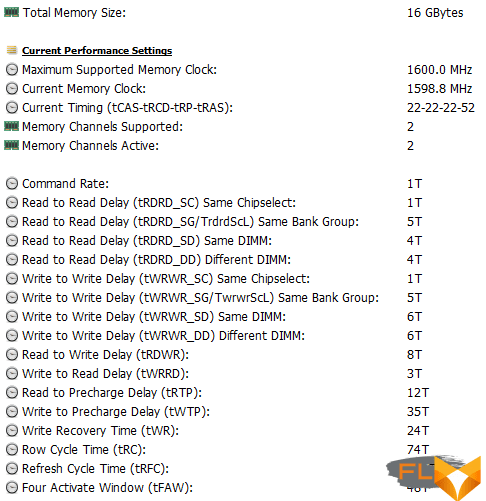
It is also not possible to increase the volume here, but when it comes to 16 GB, this is already uncritical for a “workhorse”. The speed indicators of the memory have grown significantly, which is clearly seen in the AIDA64 Extreme test.
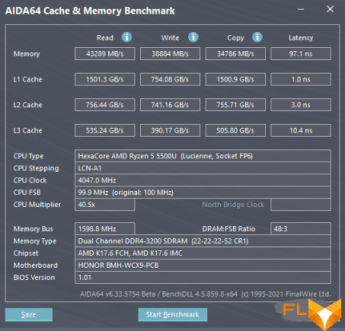
We add that a version of the new laptop with 8 GB of memory is also available for purchase, but only for a model with a 14-inch screen.
The processor update also affected the integrated graphics core AMD Radeon Graphics. The new AMD Ryzen 5 5500U contains a Lucienne core instead of the previous Renoir, which has 448 shader processors versus 384 for the Ryzen 5 4500U. In addition, in 3D modes, the GPU operates at a frequency of 1.8 GHz versus 1.5 GHz for Renoir.
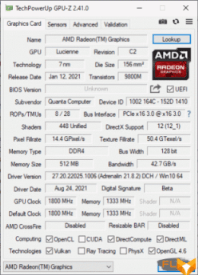
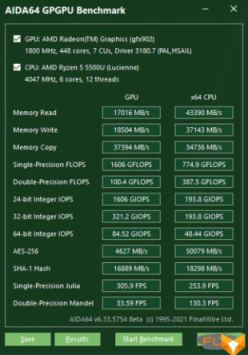
In addition, the graphics have sped up due to the faster RAM it uses. Looking ahead, we note that according to the test results, the performance gain of the integrated graphics is quite confident, but it’s better not to count on 60 FPS in some Metro Exodus.
If the changes are positive in terms of the central processor and RAM, then no changes have occurred in terms of the drive. It is still alone in the laptop, with the same capacity of 512 GB, NVMe PCIe Gen3 x4 format and manufactured by Solid State Storage Technology Corporation.

The read and write speeds declared in the characteristics of the drive are 2000 and 1300 MB / s, respectively, and the MTBF is at least two million hours.
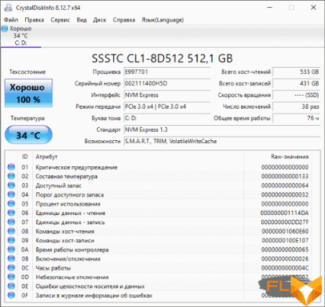
According to the test results, the SSD really turned out to be not very fast, and even when powered by a battery, its performance decreases, which is clearly seen in the results of disk utilities.
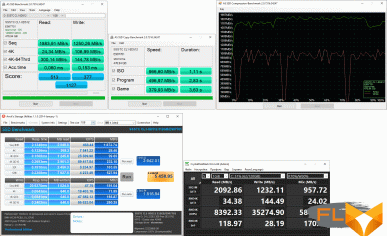

Despite the absence of any heat spreader on the drive, its temperature regime does not cause concern, since in everyday work it does not warm up above 37 °C, and in the stress test the maximum temperature reached 49 °C.

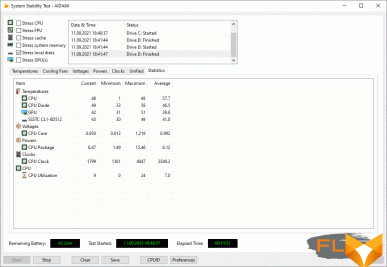
Following the new processor and improved RAM, the updated Honor MagicBook 15 received a modern wireless module. Here it is implemented by the Intel Wi-Fi 6 AX200NGW controller with support for the 802.11ax standard, frequency bands of 2.4 and 5 GHz and with a bandwidth of up to 2.4 Gb / s.
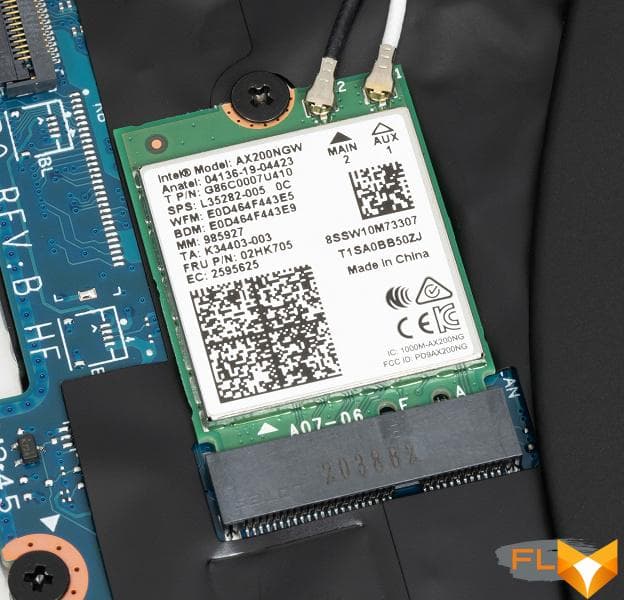
The previous model used a Realtek RTL8822CE (Wi-Fi 5) adapter.
Structurally, the laptop’s stereo speakers have not changed. Their power is still two watts per speaker, which is enough for sound reproduction, conferences or watching movies.
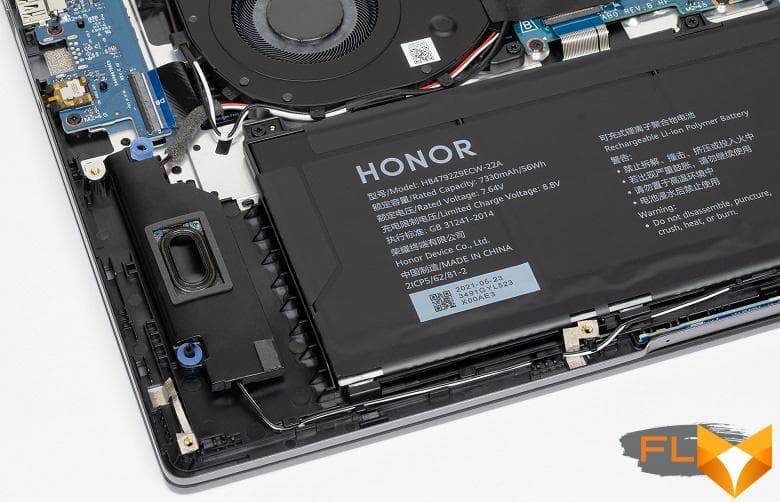

Judging by the diagnostic utilities, the Conexant CX8070 codec is now used instead of the Realtek audio codec, but, according to a subjective assessment, this replacement did not affect the sound quality in any way.
The loudness of the built-in loudspeakers was measured while playing an audio file with pink noise. The maximum volume was equal to 78.6 dBA. Among the laptops tested at the time of this writing (minimum 64.8 dBA, maximum 83 dBA), this laptop is significantly louder than average.
| Model | Loudness, dBA |
|---|---|
| MSI P65 Creator 9SF | 83 |
| Apple MacBook Pro 13″ (A2251) | 79.3 |
| Honor MagicBook 15 AMD (2021) | 78.6 |
| Asus ROG Zephyrus S17 | 77.5 |
| HP Omen 15-ek0039ur | 77.3 |
| Dell Latitude 9510 | 77 |
| MSI Bravo 17 A4DDR | 76.8 |
| Apple MacBook Air (Early 2020) | 76.8 |
| Asus ROG Zephyrus Duo 15 SE GX551 | 76 |
| MSI Stealth 15M A11SDK | 76 |
| MSI GP66 Leopard 10UG | 75.5 |
| Apple MacBook Pro 13″ (Apple M1) | 75.4 |
| Asus VivoBook S533F | 75.2 |
| Gigabyte Aero 15 OLED XC | 74.6 |
| Honor MagicBook Pro | 72.9 |
| Asus ROG Strix G732LXS | 72.1 |
| Lenovo IdeaPad 530S-15IKB | 66.4 |
| Asus ZenBook 14 (UX435E) | 64.8 |
Cooling system and load operation
The update also affected the cooling system of the Honor MagicBook 15. Although the heat dissipation of the processor did not increase, one heat pipe with a diameter of 10 mm was replaced with two pipes with a diameter of 8 and 6 mm.

In addition, the size of the radiator, to which these tubes transfer heat flow and which is cooled by a fan, has been increased.
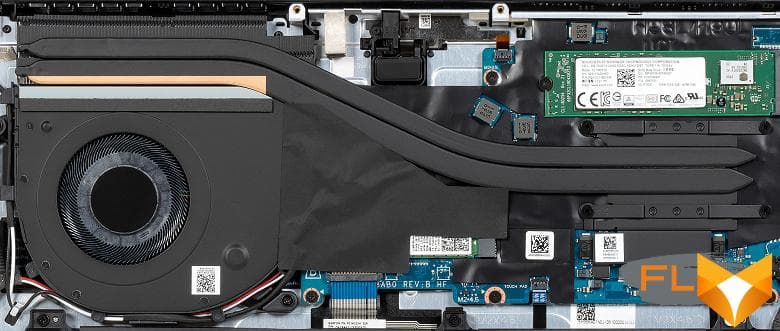
Cool air enters the laptop from below through the ventilation grill at the base and is expelled to the rear (when the lid is open).
When working from the power adapter and the mains, the Honor MagicBook 15 has two modes: productive and balanced.

We stress-tested the laptop processor using the powerMax utility (with AVX instructions) when powered by the bundled adapter, as well as when powered by a battery. Monitoring was carried out using the HWinfo64 utility, and the room temperature during the test was 23.5 °C.
The results of stress tests of a laptop when working from the mains are given in two screenshots.
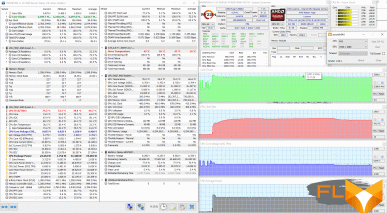
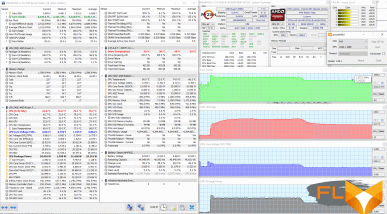
In performance mode, the laptop processor starts briskly at 3.3 GHz with power consumption above 31 watts, but then the frequency decreases first to 2.9 GHz, and then to 2.8 GHz at 24 watts. The temperature stabilizes at 74 °C, the noise level is low. The balanced mode is not critically different from the productive one: the frequency stabilization occurs at around 2.5 GHz at 18 W and 63 °C. However, in this mode, the laptop becomes barely audible, it is comfortable to work with it. Note that in stress-free modes, the updated Honor MagicBook 15 runs silently. Compared to the stress test of the previous AMD Ryzen 5 4500U model, it is clear that the new version of the MagicBook 15 is both cooler and quieter.
And here is how the laptop behaves when running on battery power, when only the balanced mode of the processor is available.
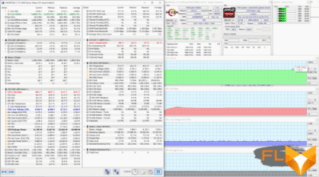
As you can see, the processor runs at a frequency just below 1.9 GHz within a TDP of 12 W and at a temperature of 49 °C.
Noise and heat
We measure the noise level in a special soundproof and semi-dampened chamber. At the same time, the sound level meter microphone is located relative to the laptop in such a way as to imitate the typical position of the user’s head: the screen is tilted back by 45 degrees (or to the maximum, if the screen does not recline by 45 degrees), the microphone axis coincides with the normal emanating from the center of the screen, the front end of the microphone is located at a distance of 50 cm from the plane of the screen, the microphone is directed at the screen. The load is created using the powerMax program, the screen brightness is set to maximum, the room temperature is maintained at 24 degrees, but the laptop is not specially blown, so in the immediate vicinity the air temperature may be higher. To estimate the real consumption, we also give (for some modes) the consumption from the network. The battery is pre-charged to 100%. In the settings of the proprietary utility, the Performance or Balanced profile is selected:
| Load Scenario | Noise level, dBA | Subjective evaluation | Power consumption, W |
|---|---|---|---|
| Balance | |||
| Inactive | background(16,5) | conditionally silent | 9,5 |
| Max CPU load | 37,8 | loud but bearable | 35-53 (maximum 56) |
| Maximum GPU load | 34,7 | clearly audible | 35 (maximum 35) |
| Maximum CPU and GPU load | 38,2 | loud but bearable | 38 (maximum 58) |
| Performance | |||
| Maximum CPU and GPU load | 37.7 | loud but bearable | 47 (maximum 62) |
If the laptop is not loaded at all, then its cooling system can work in passive mode. Even under heavy load, the noise from the cooling system is relatively low. The nature of the noise is smooth and does not cause irritation.
For a subjective assessment of the noise level, the following scale is applicable:
| Noise level, dBA | Subjective assessment |
|---|---|
| Less than 20 | conditionally silent |
| 20-25 | very quiet |
| 25-30 | quiet |
| 30—35 | clearly audible |
| 35-40 | loud but bearable |
| Above 40 | very loud |
From 40 dBA and above, the noise, from our point of view, is very high, long-term work with a laptop is difficult, from 35 to 40 dBA the noise level is high, but tolerable, from 30 to 35 dBA the noise is clearly audible, from 25 to 30 dBA noise from the system cooling will not stand out much against the background of typical sounds surrounding a user in an office with several employees and working computers, anywhere from 20 to 25 dBA a laptop can be called very quiet, below 20 dBA – conditionally silent. The scale, of course, is very conditional and does not take into account the individual characteristics of the user and the nature of the sound.
Below are thermal images obtained after long-term operation of the laptop under maximum load on the CPU and GPU (using the supplied power supply):
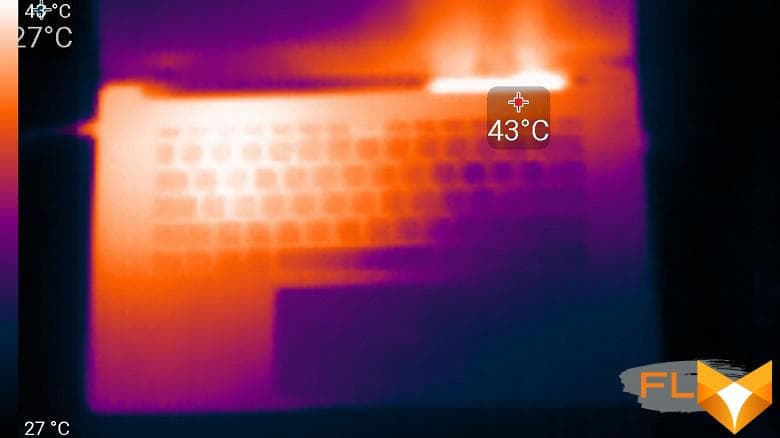
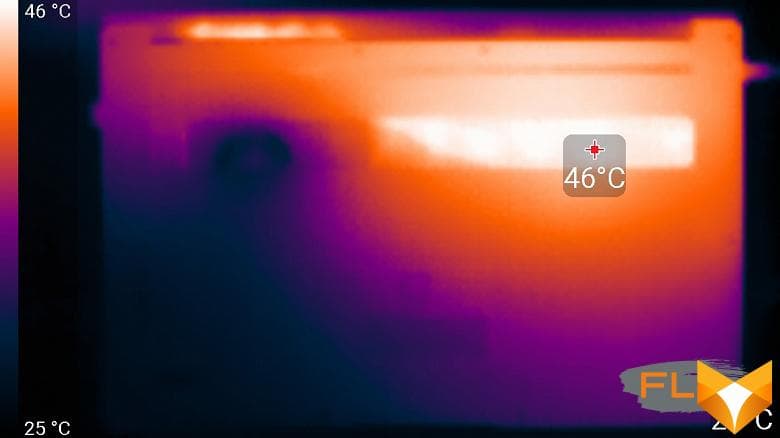
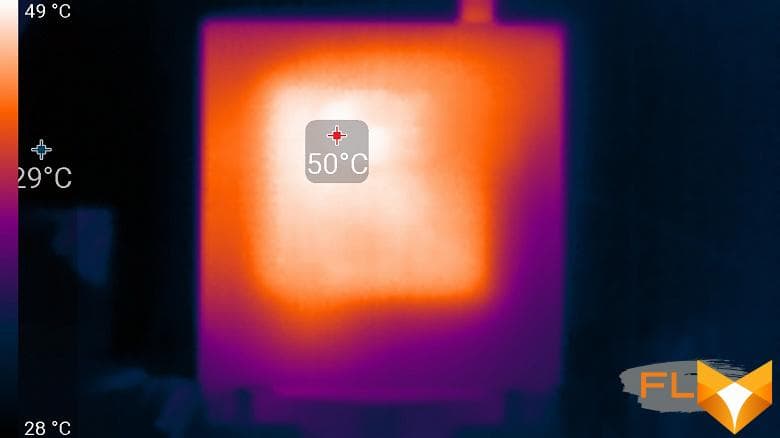
Under maximum load, working with the keyboard is uncomfortable, since the place under the left wrist heats up significantly. Keeping the laptop on your lap is also unpleasant, as the left knee comes into contact with an area of high heat. The power supply does not heat up very much, but you still need to make sure that it is not covered with anything during long-term work with high performance.
Performance
We tested the performance of the CPU, RAM and storage of the Honor MagicBook 15 BMH-WFQ9HN laptop in real applications in accordance with our methodology. For comparison, the table includes a reference system based on a 6-core Intel Core i5-9600K processor, as well as test results for Honor MagicBook 14 (NDR-WFE9HN) laptops with an Intel Core i7-1165G7 processor and Honor MagicBook 15 (BOHL-WDQ9HN) with a processor AMD Ryzen 5 4500U. All laptops were tested in maximum performance mode on mains power. The results are shown in the table.
| Test | Reference result (Intel Core i5-9600K) |
Honor MagicBook 15 BMH-WFQ9HN (AMD Ryzen 5 5500U) |
Honor MagicBook 14 NDR-WFE9HN (Intel Core i7-1165G7) |
Honor MagicBook 15 BOHL-WDQ9HN (AMD Ryzen 5 4500U) |
|---|---|---|---|---|
| Video conversion points | 100.0 | 102.6 | 62.6 | 82.8 |
| MediaCoder x64 0.8.57, c | 132,03 | 117,74 | 200,55 | 154,69 |
| HandBrake 1.2.2, c | 157,39 | 157,98 | 256,64 | 188,23 |
| VidCoder 4.36, c | 385,89 | 398,91 | 634,02 | 484,97 |
| Rendering points | 100.0 | 110.8 | 70.7 | 84.9 |
| POV-Ray 3.7, c | 98,91 | 93,90 | 172,10 | 119.75 |
| Cinebench R20, c | 122,16 | 109,34 | 172,46 | 139,51 |
| Blender 2.79, c | 152,42 | 140,42 | 223,52 | 191,12 |
| Adobe Photoshop CC 2019 (3D rendering), c | 150,29 | 127,58 | 166,80 | 166,52 |
| Video content creation, points | 100.0 |
94.5 | 97.7 | 84.4 |
| Adobe Premiere Pro CC 2019 v13.01.13, c | 298,90 | 311,29 | — | 416,05 |
| Magix Vegas Pro 16.0, c | 363,50 | 558,00 | 513,00 | 636,00 |
| Magix Movie Edit Pro 2019 Premium v.18.03.261, c | 413,34 | 460,16 | — | 494,21 |
| Adobe After Effects CC 2019 v 16.0.1, c | 468,67 | 421,00 | 311,00 | 521,00 |
| Photodex ProShow Producer 9.0.3782, c | 191,12 | 159.00 | 224,44 | 193,72 |
| Digital photo processing, points | 100.0 | 80.6 | 94.8 | 87.9 |
| Adobe Photoshop CC 2019, s | 864,47 | 905,43 | 765,96 | 894,48 |
| Adobe Photoshop Lightroom Classic CC 2019 v16.0.1, c | 138,51 | 190,95 | 139,30 | 152,15 |
| Phase One Capture One Pro 12.0, c | 254,18 | 335,56 | 334,92 | 329,47 |
| Text recognition score | 100.0 | 118.9 | 74.9 | 85.4 |
| Abbyy FineReader 14 Enterprise, c | 491,96 | 413,72 | 656,44 | 576,20 |
| Archiving, points | 100.0 | 90.2 | 91.5 | 69.5 |
| WinRAR 5.71 (64-bit), c | 472,34 | 542,02 | 498,46 | 711,08 |
| 7-Zip 19, c | 389,33 | 417,36 | 440,42 | 535,08 |
| Scientific calculations, points | 100,0 | 97,8 | 73,5 | 80,4 |
| LAMMPS 64-bit, c | 151,52 | 146,29 | 138,99 | 190,44 |
| NAMD 2.11, с | 167,42 | 163,35 | 279,97 | 247,34 |
| Mathworks Matlab R2018b, c | 71,11 | 71,98 | 128,22 | 87,48 |
| Dassault SolidWorks Premium Edition 2018 SP05 with Flow Simulation 2018, c | 130,00 | 149.00 | 161.00 | 171.00 |
| Integral result without accumulator, points | 100,0 | 98.6 | 79.8 | 82.0 |
| WinRAR 5.71 (Store), c | 78,00 | 95,99 | 23.97 | 42,56 |
| Data copying speed, c | 42,62 | 48,16 | 10,98 | 19,88 |
| Integral result of the accumulator, points | 100,0 | 84,8 | 355.5 | 198,2 |
| Integral performance result, points | 100,0 | 94.3 | 125.0 | 106,9 |
With an AMD Ryzen 5 5500U processor and fast memory, the new Honor MagicBook 15 really did well in multi-threaded tests, where it can outperform its predecessor with an AMD Ryzen 5 4500U processor by up to 30%. However, the cumulative performance result is lower due to the slow SSD installed in this laptop model. Hopefully, next year, Honor will update its MagicBook 15 once again, finally equipping it with a fast SSD and modern ports.
In addition to processor tests, one cannot fail to note the performance increase in 3D tests. So, for example, in four 3DMark benchmarks, GPU performance increased by 20% -30%, and in World of Tanks – by 20%.
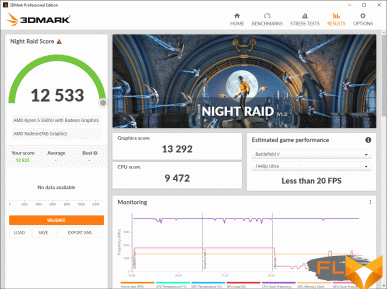
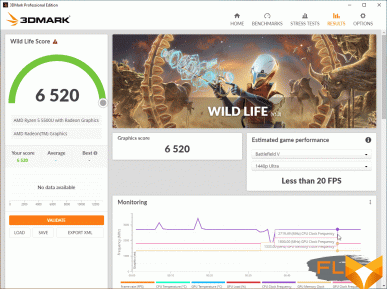
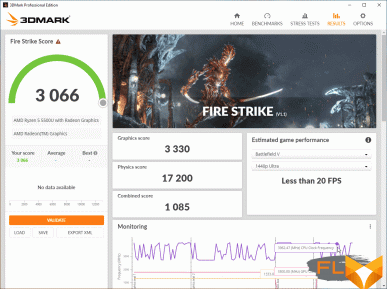


Now it is almost the same level as the Intel Iris Xe Graphics.
Battery life
The upgraded Honor MagicBook 15 comes with a 65W (20V, 3.25A) USB Type-C power adapter HN-200325EP0.
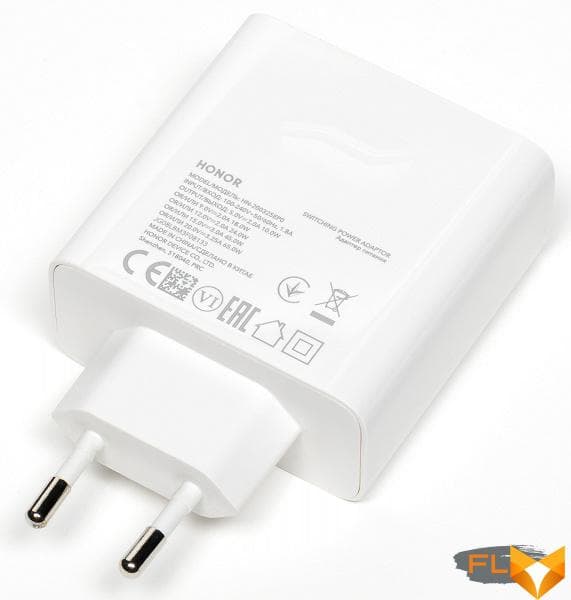
The length of the connecting cable is 1.75 meters, when the power is connected to the laptop, a white LED next to the connector lights up.
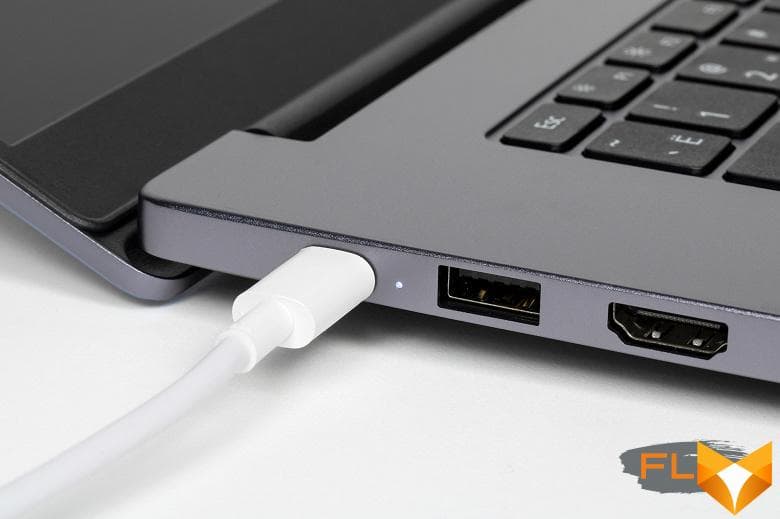
If last year’s Honor MagicBook 15 was equipped with a 42 Wh (3665 mAh) battery, the new version of the laptop received a 56 Wh (7330 mAh) battery.
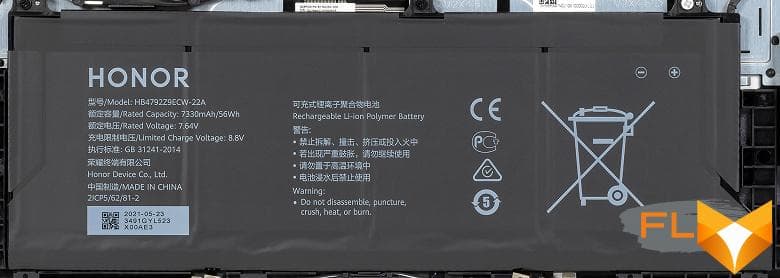
According to HWinfo64, the battery capacity turned out to be slightly less than stated and is 55 Wh.
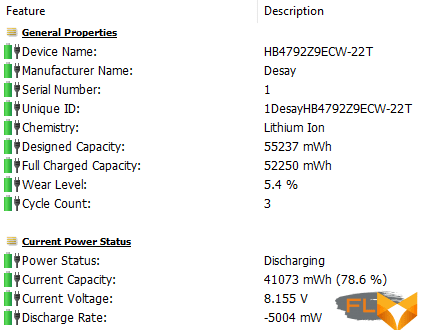
Honor claims that the first 65% of the battery is gaining no more than an hour, which is true, but it took 1 hour and 59 minutes to fully charge the laptop (arithmetic average of the results of four charge cycles with 5% up to 100%). That is, the laptop has become uncritically longer to charge than its predecessor with an AMD Ryzen 5 4500U processor.
We tested the MagicBook 15’s battery life in PCMark’10 with a screen brightness of 100 cd/m² (equivalent to 49% in this case) and got the following results.
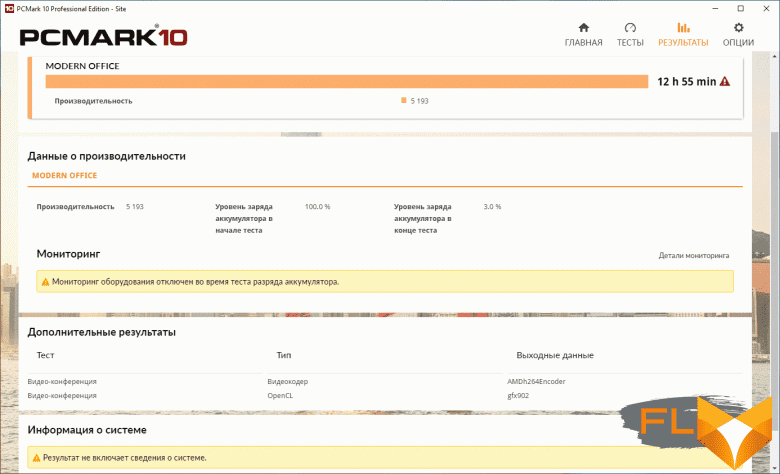
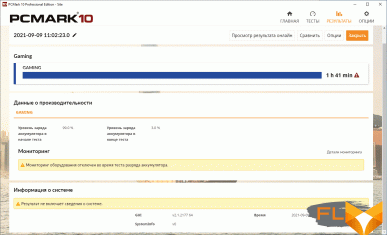
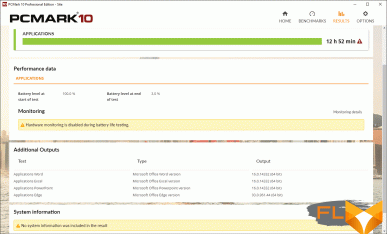
An increase in the battery with the same thermal package of the processor had a positive effect on the autonomy of the Honor MagicBook 15. If the best result of last year’s laptop model was 9 hours and 25 minutes (Modern Office test), then the new version in the same test worked for almost 13 hours, as in the test PCMark’10 Application. Only the operating time of the laptop in gaming mode remained the same – 1 hour and 41 minutes. The duration of viewing the video sequence on the laptop was almost 14 hours. At the same time, no artificial restrictions were introduced, network connections were active, the sound volume was set at 25%.
Conclusions
The new model of the Honor MagicBook 15 laptop with the BMH-WFQ9HN index only does not differ from its predecessor in appearance, but in fact, with the exception of a couple of points, this is already a new laptop, and more interesting than before. First of all, the poor quality of the IPS screen of the previous model has changed to high, the brightness has increased from 265 to 358 cd/m². We also add here the color gamut increased to 100% sRGB and TÜV Rheinland certificates for reducing blue light and flicker suppression.

The laptop’s CPU is now up to 30% more efficient, and that’s with the same thermal package, as well as less heat and noise, thanks to an improved cooling system. In 3D, we also note a noticeable performance increase. Doubled – up to 16 GB – increased the amount of RAM, which, moreover, has a higher frequency. The wireless network is now Wi-Fi 6 with a throughput of up to 2.4 Gbps. Finally, the battery capacity has increased and battery life has significantly increased, which is also an undoubted plus of the updated MagicBook 15 model.
From what could be improved, but not improved, is a keyboard without a number pad with narrow arrows and no backlight, an uncomfortable webcam, only one fast USB and a lack of USB ports, no card reader, and also not too fast SSD . Let’s not forget that the cost has increased by $150 and is now $1200. But if you have time to buy on pre-order with gifts, then we can say that there is no increase in cost.
